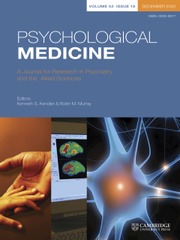Crossref Citations
This article has been cited by the following publications. This list is generated based on data provided by
Crossref.
Huddlestone, Lisa
Sohal, Harpreet
Paul, Claire
and
Ratschen, Elena
2018.
Complete smokefree policies in mental health inpatient settings: results from a mixed-methods evaluation before and after implementing national guidance.
BMC Health Services Research,
Vol. 18,
Issue. 1,
Brose, Leonie S.
Simonavicius, Erikas
and
McNeill, Ann
2019.
Rejoinder relating to correspondence by Dr Eleanor Woodward, Professor Robyn Richmond on Brose LS, Simonavicius E, McNeill A (2018). Maintaining abstinence from smoking after a period of enforced abstinence.
Psychological Medicine,
Vol. 49,
Issue. 2,
p.
347.
Woodward, E.
and
Richmond, R.
2019.
Maintaining abstinence from smoking after a period of enforced abstinence: considerations of non-compliance and the significance of reduced smoking [Psychological Medicine, 2018, 48, 669–678].
Psychological Medicine,
Vol. 49,
Issue. 2,
p.
345.
Woodward, Eleanor R.
and
Richmond, Robyn
2019.
Smoking Bans in Psychiatric Units: An Issue of Medical Ethics.
Frontiers in Psychiatry,
Vol. 10,
Issue. ,
Chan, Hung-Yu
Chen, Jiahn-Jyh
Pan, Yi-Ju
and
Hsu, Chun-Chi
2020.
Nicotine Replacement Therapy and Healthy Lifestyle Psychoeducation for Smoking Reduction in Acute Psychiatric Inpatients.
Journal of Clinical Psychopharmacology,
Vol. 40,
Issue. 2,
p.
149.
Bonevski, Billie
Manning, Victoria
Wynne, Olivia
Gartner, Coral
Borland, Ron
Baker, Amanda L
Segan, Catherine J
Skelton, Eliza
Moore, Lyndell
Bathish, Ramez
Chiu, Simon
Guillaumier, Ashleigh
and
Lubman, Dan I
2021.
QuitNic: A Pilot Randomized Controlled Trial Comparing Nicotine Vaping Products With Nicotine Replacement Therapy for Smoking Cessation Following Residential Detoxification.
Nicotine & Tobacco Research,
Vol. 23,
Issue. 3,
p.
462.
Guillaumier, Ashleigh
Skelton, Eliza
Tzelepis, Flora
D'Este, Catherine
Paul, Christine
Walsberger, Scott
Kelly, Peter J.
Palazzi, Kerrin
and
Bonevski, Billie
2021.
Patterns and predictors of nicotine replacement therapy use among alcohol and other drug clients enrolled in a smoking cessation randomised controlled trial.
Addictive Behaviors,
Vol. 119,
Issue. ,
p.
106935.
Shoesmith, Emily
Huddlestone, Lisa
Lorencatto, Fabiana
Shahab, Lion
Gilbody, Simon
and
Ratschen, Elena
2021.
Supporting smoking cessation and preventing relapse following a stay in a smoke‐free setting: a meta‐analysis and investigation of effective behaviour change techniques.
Addiction,
Vol. 116,
Issue. 11,
p.
2978.
Plugge, Emma
and
Leclerc, Elena
2021.
Smoking bans in prisons.
The Lancet Public Health,
Vol. 6,
Issue. 11,
p.
e781.
Sourry, Rebecca J.
Hyslop, Fran
Butler, Tony G.
and
Richmond, Robyn L.
2022.
Impact of smoking bans and other smoking cessation interventions in prisons, mental health and substance use treatment settings: A systematic review of the evidence.
Drug and Alcohol Review,
Vol. 41,
Issue. 7,
p.
1528.
Andreas, Stefan
Batra, Anil
Brüggmann, Dörthe
Geyer, Dieter
Gohlke, Helmut
Hering, Thomas
Jähne, Andreas
Jückstock, Julia
Klein, Marianne
Kotz, Daniel
Kröger, Christoph
Krüger, Timo
Kölch, Michael
Lesta, Evelyn
Lindenmeyer, Johannes
Lindinger, Peter
Mons, Ute
Mühlig, Stephan
Neumann, Tim
Petersen, Kay Uwe
Polak, Thomas
Preuss, Ulrich W.
Pötschke-Langer, Martina
Rustler, Christa
Rüther, Tobias
Schiller, Sophie Luise
Schwarz, Christiane
Schweizer, Cornelie
Thomasius, Rainer
Ulbricht, Sabina
and
Veltrup, Clemens
2022.
S3-Leitlinie Rauchen und Tabakabhängigkeit: Screening, Diagnostik und Behandlung.
p.
41.
Asharani, P. V.
and
Subramaniam, Mythily
2022.
Handbook of Substance Misuse and Addictions.
p.
775.
Asharani, P. V.
and
Subramaniam, Mythily
2022.
Handbook of Substance Misuse and Addictions.
p.
1.
Kanniah, Guna
and
Kumar, Rishi
2023.
A selective literature review exploring the role of the nicotinic system in schizophrenia.
General Psychiatry,
Vol. 36,
Issue. 2,
p.
e100756.
Plever, Sally
Kisely, Steve R
Bonevski, Billie
Siskind, Dan
Guillaumier, Ashleigh
McCarter, Kristen
and
Gartner, Coral E
2024.
Interventions for smoking cessation in inpatient psychiatry settings.
Cochrane Database of Systematic Reviews,
Vol. 2024,
Issue. 9,
Bonevski, Billie
Rich, Jane
Lubman, Dan I
Segan, Catherine
Baker, Amanda
Borland, Ron
Oldmeadow, Chris
Gartner, Coral
Walker, Natalie
Dunlop, Adrian
Daglish, Mark
Bullen, Christopher
Bauld, Linda
Jacka, David
Garfield, Joshua B B
McCrohan, Rose
Guillaumier, Ashleigh
and
Manning, Victoria
2025.
Nicotine e-cigarettes for smoking cessation following discharge from smoke-free inpatient alcohol and other drug withdrawal services: a pragmatic two-arm, single-blinded, parallel-group, randomised controlled trial.
The Lancet Public Health,
Vol. 10,
Issue. 7,
p.
e568.
Petersen Williams, Petal
Huddlestone, Lisa
Shoesmith, Emily
Brady, Samantha
Mitchell, Alex
Exley, Victoria
Wiggins, Fraser
Sinclair, Lesley
Pervin, Jodi
Horspool, Michelle
Leahy, Moira
Paul, Claire
Colley, Lesley
Shahab, Lion
Watson, Judith
Hewitt, Catherine
Hough, Simon
Britton, John
Coleman, Tim
Gilbody, Simon
Parrott, Steve
Galdas, Paul
Russell, Gregor
Coventry, Peter A
and
Ratschen, Elena
2025.
Promoting smoking cessation and preventing relapse to tobacco use following a smoke-free mental health inpatient stay (SCEPTRE feasibility study): a multicentre randomised controlled feasibility study protocol.
BMJ Open,
Vol. 15,
Issue. 6,
p.
e094441.

